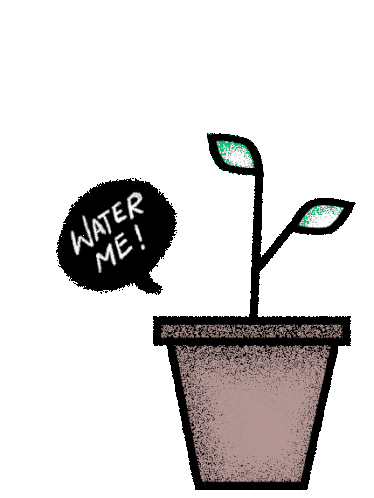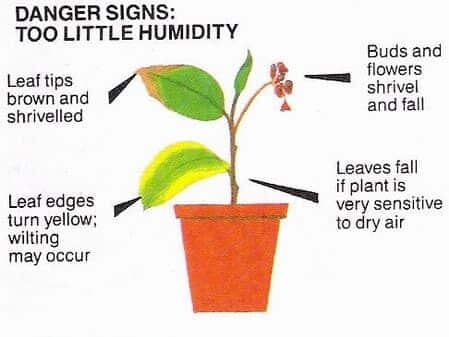Prayer plants (Maranta leuconeura) are popular for their amazing leaves, which lay flat during the day and fold at night. It sort of looks like it is praying.
Seeing drooping or wilted leaves on your beloved Prayer plants may be alarming to you. I was so nervous when I first noticed my Prayer plant drooping.
Later, I found out that I had placed my Maranta too close to the window, which resulted in excessive exposure to sunlight, which also led to underwatering problems due to the soil drying too quickly.
So, why does the Prayer plant has sad drooping leaves?
The imbalance in one parameter or combination of different parameters (light, watering, humidity, temperature, and others) causes droopiness in the Prayer plant.

Since Maranta is a tropical plant, you have to create a similar environment in your home.
Watch out if the plant is dropping in the day or evening. Normally if it is drooping in the evening or night, it’s the praying behavior.
This article will help you to know the possible causes of droopy leaves on your Prayer plant and how you can solve and prevent the problem.
Table of Contents Show
Is it Normal for the Prayer Plant to Droop?
There are different causes of droopy leaves on your Maranta plant. Don’t get confused; they just might be praying.
You can say that it is Normal for the Prayer plant to appear droopy.
If the droopy leaves are only for a certain time of the day, then you got nothing to worry about. There is a problem the droopiness is constant.

Therefore, first, you need to make sure by examining the plant.
Take account of its droopy behavior, its environment, and your habits of watering, fertilizing, preparing the potting mix, etc., to know the real reason for droopiness.
Before going into detail, the table below shows the causes of the drooping Prayer plant and the solutions.
| Causes of drooping Prayer plant | Solutions |
|---|---|
| Improper watering | Maintain consistent watering schedule. Don't use tap water. |
| Too much Sunlight | Don't expose the plant to direct sunlight |
| Low Humidity | Maintain medium to high humidity |
| Pests and Disease | Control pest and disease infestations |
| Temperature Extremities | Maintain ideal temperature 65–85°F (18–30°C) |
| Dry Soil Mix | Prepare the right potting mix consisting of peat moss, perlite, and compost |
| Excess Fertilizer | Fertilize every two weeks from early spring to fall not more |
If you notice the droopiness in your Prayer plant quite early, you can save the plant easily.
However, noticing the droopiness after the condition worsens with yellow and dying leaves makes it difficult to revive.
Recommended Prayer plant reading that may be helpful to you: How to Revive a Prayer Plant | The Easy Way Possible
Prayer Plant Drooping: Reason and What to do?
1. Improper Watering
The droopy leaves may be an outcome of both under and over-watering. Other than the quantity of water, its quality is also equally important.
Water Quantity
Moisture-loving Prayer plant needs water before the soil completely dries out. It stresses out in the absence of sufficient water.

The immediate remedy is to pour the water thoroughly, and your plant will rise again.
It may seem strange, but overwatering also causes drooping leaves.
Wondering how? Watering the plant more than needed results in root rot in soggy soil, which gives rise to fungal infections.

The remedy for overwatering is lengthy if the condition of the plant is worse.
You have to remove the whole plant from the pot again, cut the damaged roots with sterilized scissors and then repot the prayer plant in the fresh potting mix.
Water Quality
You can only use the tap water for the plant after filling it and leaving it for a day. By doing this, tap water chemicals evaporate and will be safe for watering.
Tap water is hard and contains excess minerals. Watering with tap water is like over-fertilizing your plant. Tap water burns roots and the roots fail to absorb water and minerals.
You can see the white powder that is actually calcium along the pot’s rims. Remember, it is due to tap water.
Preventive Measures against Improper Watering
- Don’t water the plants with tap water; instead, use distilled or rainwater.
- Use the suitable well drainage potting mix.
- Water the plant thoroughly until the water runs from the drainage holes.
- Choose a container with enough drainage holes.
- Water the plant only when the top 1-2 inches of soil is dry. You can stick your finger a few inches in the soil and examine the moisture.
- Another option to examine soil moisture is investing in a soil sensor or moisture meter. It helps you to track and maintain a good watering schedule.
2. Excessive Sunlight
Exposing the plant to light for long durations causes scorches, droopiness, burnt leaves, and yellow leaves with brown spots.

The plant gets too much light when it is exposed to direct sunlight. Similarly, Keeping the plant too close to the window also results in more sunlight than needed.
You can get the help of a light meter to know how much light your Maranta is getting. It works magic and helps you adjust the plant’s lighting needs.
The immediate remedy is to place the plant in a spot where it receives less or low-intensity light.
Preventive Measures against Harsh Sunlight
- Keep the plant 2-3 feet far from the window.
- Don’t expose the plant to direct sunlight; instead, use sheer curtains.
- Don’t place the plant the whole day in the southern window in the summer because the sun’s ray is intense.
Give it some time with its favorable lightning, and it will surprise you by rising again.
3. Temperature Extremities: High and Low
Prayer plants have droopy leaves under both extreme and low temperatures.
In high temperatures, the plant loses water level quickly and can kill its cells if left in that situation for more time. This results in wilted, dry, and yellow leaves.
Similarly, under a low temperature, the cell in the plant becomes inactive, causing drooping and wilted leaves on the Prayer plant.

Therefore, you must protect the plant from the harsh summer sun and the freezing frost of winter.
Generally, Prayer plants enjoy warm temperatures between 65–85°F (18–30°C).
Tips to Maintain Proper Temperature
- Avoid placing the plant near heaters and fans. They dry the air.
- During winter, bring the plant indoors to protect the Prayer plant from frost and freezing cold.
- Place the plant in a cool spot, under the shade of other plants, or 3-4 feet away from the window in summer.
- Frost covers or Heading pads can be used as winter protection.
- Regular misting in summer can help your plant to cool down.
4. Low Humidity
Native to the tropical environment, the Prayer plant enjoys humid surroundings. Generally, they need a medium to high humidity.

A good goal is to keep the humidity level around or above 50%.
Tips to Maintain the Humidity Level
- Relocate the plant to another spot with sufficient humidity. Bathrooms and kitchens have more humidity levels than other rooms, so keeping Prayer plants in these spots is best.
- Mist the leaves frequently, usually in the morning or day.
- Put the pebbles on a tray with water; the water evaporates and provides humidity for the plant.
- Keep a humidifier, as it is the best way to increase humidity in your home.
5. Dry Soil Mix
Prayer plants thrive in moist soil. Letting the plant dry completely without a consistent watering schedule makes the soil dry.

Similarly, improper soil mix and high temperature expose the plant to the beaming sun for long, causing drooping and unhappy leaves.
Solutions and Preventive Measures
- Slowly remove the plant thoroughly from the top.
- Fill half of the sink with water and put your prayer plant pot with drainage holes till the soil absorbs water and becomes moist.
- Prepare the right potting mix consisting of peat moss, perlite, and compost. You can also use an all-purpose potting mix.
Also Watch,
6. Excess Fertilizer
Feeding your Prayer plant with more fertilizer than needed does more harm.
According to Penn State Extension, over-fertilizing your potted plants increases the soluble salt concentration in the soil mix, which clots the roots.
Generally, Prayer plants need fertilization every two weeks, from early spring to fall. Therefore, make sure not to fertilize more than recommended.
Excessive use of fertilizer can burn and damage the roots and prevent them from absorbing and carrying water and nutrients to other parts of plants; hence wilting and drooping occur in your plant.
Wash the soil by simply putting lots of water on the base of the plant in case of over-fertilization.
The best thing to do is to use the recommended fertilizer sparingly. In case of a forgetful habit, make a fertilizing schedule and stick to it.
But do not overfertilize your Prayer plant.
Pro Tip- Always water your Plant before applying the fertilizer.
7. Pests and Disease
Common pests like aphids, spider mites, thrips, and mealybugs suck the juices and nutrients from the Prayer plant and weaken the plants.

As a result, droopy and wilted leaves are common in the Maranta plant.
Not only pests but several diseases also cause droopiness and wilted leaves.
The fungal infection seen on the plant due to root rot prevents plants from absorbing water and nutrients from the roots.
Likewise, Bacterial disease damages plant tissue and stem, making plants unable to function correctly—all these are directed toward the droopy leaves.
Solution and Preventive Measures
- Check the plant before bringing it. Isolate it in case of even the slightest doubt of pest or disease infestation.
- Use insecticidal soap and horticulture oil to spray the plant
- I recommend you remove the intense damaged parts of the Prayer plant so you can prevent the disease from spreading
- Spray neem oil on the foliage. Using neem oil is the natural and best way to control pests and diseases.
- You can shower the plant occasionally with lukewarm water. It helps to remove dust and pests. Bring the plant indoor-only after it is dry.
Other Possible Causes of Drooping Prayer Plant
- Accidental physical damage
- Repotting or Transplant Stress ( Generally, plants pass through stress after repotting and potting. However, they go back to normal after adjusting to the situation)
- Rootbound (In case of root bound, the roots cannot function properly, so you have to repot the prayer plant)
Fascinated by the Prayer plant? Learn about 15 Different Types of Prayer Plants.
To Conclude
Your Prayer plant follows the rhythm of the sun, and if you follow the tips mentioned above, you can protect your adorable plant from drooping.
Get Maranta from plant stores and online stores. The striking, beautiful, broad, and painterly leaves with variegated shades of green will give your home a splash of color.
Feel free to leave comments if you have any questions.
Happy plant parenting!


